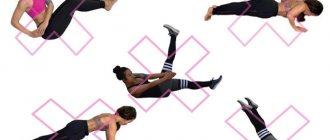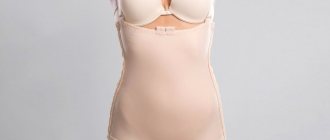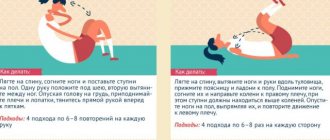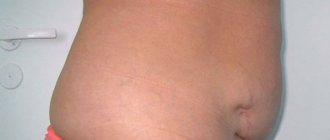Separation of the rectus abdominis muscles, or diastasis, is a common problem affecting mostly women. According to statistics, 70-100% of women develop this pathology in the third trimester of pregnancy. Normally, after childbirth, the structures should return to their original position, but in approximately 30% of cases this does not happen. A gap remains between the muscle tissues, which causes a bulging, flabby abdomen and provokes more serious consequences. That is why it is important to know how to determine diastasis of the abdominal muscles at home, which doctor can help, and what treatment methods modern medicine offers.
Diastasis: definition of the concept
The abdomen has powerful muscles and the following main groups can be distinguished: • external - oblique and rectus muscles, the latter forms the much-desired “cubes” on the abdomen; • internal - transverse and oblique muscles, their main task is to maintain the position of the organs. The rectus muscles are separated by a thin tendon membrane - also known as the linea alba. A lot depends on her postpartum condition. Normally, the distance between the muscles is no more than 20 mm. But under the influence of certain reasons, the tendon membrane is weakened, overstretched, and neighboring muscles diverge. This condition is called diastasis recti. Several types of diastasis have been identified. The classification is based on the area of divergence: above or below the navel, or a mixed version. Symptoms and prognosis largely depend on this.
Causes
The diagnosis of “diastasis” is made to 2-3 out of 10 women after the birth of a baby.
Risk groups have also been identified: the likelihood of rectus muscle divergence is higher in women with a fragile physique who do not play sports. Mothers of large families with children with a small age difference are also at risk. Statistically, diastasis is recorded less often in active women, with developed and trained rectus abdominis muscles and normal weight.
There is a direct connection between improperly functioning muscles of the thoraco-abdominal diaphragm, pelvic floor and abdomen, and disruption of their coordinated work, which leads to their dysfunction. This is one of the reasons for the increase in intra-abdominal pressure and, as a result, leads to diastasis. Pregnancy and childbirth are other obvious causes of increased intra-abdominal pressure. There are several explanations for this: the growth of the fetus and uterus. A role is played by the production of the hormone relaxin, which helps to “soften” the ligamentous apparatus of the pelvic bones for the possibility of natural childbirth. But relaxin also acts on the linea alba, which can provoke its weakness and, as a consequence, the formation of diastasis.
Predisposing factors in the development of diastasis with its possible complications can be considered pregnancy with twins or triplets, high fetal weight at the time of birth, difficult and prolonged delivery.
Diastasis is quite possible in men and even children. Therefore, pregnancy and childbirth are not the only reasons, there are others: • Congenital features The white line (aponeurosis) is formed by connective tissue. With its congenital weakness, the likelihood that the muscles will begin to diverge significantly increases. To prevent complications, it is important to identify a predisposition to discrepancy even before pregnancy, taking preventive measures: strengthening them using therapeutic exercises. • Diseases and dysfunctions of the intestines Chronic constipation is one of the causes of increased intra-abdominal pressure. Its prolonged existence in combination with other factors increases the risk of divergence. In general, rapid weight gain, obesity, a sedentary lifestyle and a number of chronic diseases are dangerous, one of the symptoms of which is increased intra-abdominal pressure. • Strength training People who practice heavy strength training are at risk of encountering diastasis. Coaching mistakes and excessive load are not only a risk factor for diastasis, but also its complications, for example, umbilical hernia.
It is extremely important to identify muscle discrepancies in a timely manner, otherwise an incorrectly selected set of exercises that train the abdomen and its muscles, especially during the postpartum recovery period, will lead to serious complications - increased discrepancies between the muscles.
Self-diagnosis of diastasis
If you suspect you have diastasis, we suggest you perform a self-diagnosis using video and record the results. To record, you can use the table in the infographic below or any medium convenient for you.
Diastasis is measured using three parameters:
- Divergence length . Measure how many centimeters the muscles extend up and down from the navel.
- Width of divergence . Measure how many centimeters there are between the muscles above and below the navel.
- Finger insertion depth . Evaluate how much your fingers sink when performing the test. During the recovery process, you will learn to engage the transverse abdominis muscle and the depth of immersion of your fingers during the test will become less.
Record your self-test results in a table to track changes.
During each test, observe the following aspects:
- Assess whether you experience pain in the pubic symphysis (the joint of the pubic bones).
- Try to feel the boundaries of the muscles along the middle of your abdomen and evaluate whether it is a soft tear or a clear separation of the muscles.
- See if you see a bulge or ridge.
- Listen to the sensations - do you experience discomfort in the pelvic floor (involuntary release of urine, release of gas, air from the vagina).
If something alarms you while performing these points, you should consult with your doctor to fully assess the condition of the abdominal cavity and/or pelvic organs before starting a cycle of exercises to correct diastasis.
Self-diagnosis of diastasis
How to independently determine diastasis?
When preparing for pregnancy, it is recommended to visit a number of doctors and identify diastasis and predisposition to it - one of the points of mandatory examination. At the Quality of Life clinic, specialists will not only be able to identify, but also eliminate the problem using non-surgical methods, helping to recover faster after childbirth, avoiding complications. The discrepancy of the rectus muscles is detected independently, and complex examination methods are not needed - if you tense the abdomen, then a longitudinal ridge will be noticeable in its center, just in the area of the white line. There are other tests available at home: • take a lying position with your knees slightly bent; • the right or left hand should be located in the back of the head; • with the fingers of the other hand, focusing on the navel, find the midline; • lifting up and simultaneously twisting the torso, you need to look for the “failure” with your fingers. If there is a dip in the stomach of no more than two centimeters, approximately 1-1.5 fingers, there is no reason to worry. But as part of pregnancy planning, a doctor’s consultation is not included. Depending on the size of the discrepancy, the following degrees of diastasis are distinguished: • I – does not exceed 22-50 mm; • II - about 51-70 mm; • III – more than 71 mm. In this case, the protrusion is constant, does not depend on straining, and its configuration changes.
Immediately after the birth of the baby, the muscles may diverge by up to 3 cm - this is normal. To shorten the recovery period without causing complications, medical care is needed in the early postpartum period.
Exercise "Vacuum"
Vacuum can be combined with posture and breathing exercises. Carry out sequential mastery of the exercise in the starting positions lying on your back, then on all fours, and then standing.
We talk more about vacuum and the technique of performing it in the article “Will vacuum exercise help make your stomach flat?”
Often after childbirth, women are faced with the fact that diastasis does not converge on its own. Our body has a resource for recovery, but sometimes it needs help. The postpartum period is one such case. #sekta has a course for mothers to recover after childbirth, which we recommend to anyone who has complaints about diastasis.
In the course, complexes for correcting diastasis are part of the training load. They are performed three times a week or more often and combine work with breathing, back muscles and the inclusion of the abdominal muscles: rectus and oblique. The result of this work is a reduction in diastasis and a decrease in the depth of immersion of the fingers along the entire length of the white line of the abdomen.
Regularity is important in the process of correcting diastasis. Recovery will be slower if you train occasionally or do training constantly, but do not monitor your movements in everyday life.
The course complexes for mothers are suitable for the correction of first and second degree diastasis. For third-degree diastasis, consultation with a surgeon is necessary to choose a correction method.
In this article we shared only a small part of our knowledge and gave direction for work. This is not an instruction for action, but a basis for developing a plan to combat diastasis.
Authors: obstetrician-gynecologist Valeria Pushkina, Department of Women's Diseases and Reproductive Health at the National Medical Center named after. N.I. Pirogova, Daria Knyazeva, group program instructor, postpartum recovery specialist, trainer-methodologist at the Ideal Body School #Sekta
Literature:
1. https://dianelee.ca/article-diastasis-rectus-abdominis.php. 2. Lee DG 2004 The Pelvic Girdle 3rd edn. Elsevier SyntaxError. 3. Lee DG 2007 Clinical Reasoning and Pelvic Girdle Pain: Show me the Patient! In: Proceedings of the 6th World 4. Congress on Low Back and Pelvic Girdle Pain, Barcelona, Spain, p 27. 4. https://dianelee.ca/article-diastasis-rectus-abdominis.php#sthash.ACQZUzfw.dpuf . 5. https://www.befitmom.com/diastasis_recti.php. 6. https://www.physiotherapy-treatment.com/diastasis-recti.html. 7. Fit Healthy Moms. 3 Ab Exercises to Heal Diastasis Recti. Available from: https://www.youtube.com/watch?v=Q6SfiH2-TEQ. 8. MomsIntoFitness. Diastasis Recti Exercises 5 min Core Workout. 9. Lee D, Lee LJ, McLaughlin L 2008 Stability, continuity and breathing: the role of fascia following pregnancy and delivery. JBMT 12(4):333–348. 10. Lee D 2011 Chapter 6 Pregnancy and its potential complications. 11. Lee D 2011 The Pelvic Girdle - An integration of clinical expertise and research, Elsevier.
Why is divergence dangerous?
The most striking consequences of diastasis are a bulging belly and a change in its configuration and overall figure. Symptoms become most pronounced 2-3 months after delivery. In an attempt to regain their previous shape, women take up active physical exercise. But the problem remains and even becomes more serious and pronounced. Diastasis is far from just an aesthetic problem. When the integrity of the abdominal wall is violated, caused by the divergence of the rectus muscles, typical complaints arise: pain in the lumbar area, disorder of venous blood flow in the pelvis, congestion in the veins of the legs and thighs, which contributes to the development of varicose veins and the threat of thrombosis. This is also one of the reasons for the prolapse of internal organs, which is a predisposing factor and the cause of urinary incontinence and frequent cystitis (inflammation of the bladder).
Problems with the digestive tract are also common - chronic constipation, dyspeptic disorders: pain or discomfort, a feeling of rapid satiety, stomach turmoil, nausea, even vomiting, belching and heartburn.
The best treatment for diastasis and its complications is prevention, because it is possible to reduce its likelihood. The main thing is to strengthen the muscles even at the stage of pregnancy planning. Then even the formed problem will go away on its own and painlessly.
Symptoms
The clinical picture depends on the degree of development of the disease. So in the initial stages, when the stretching of the aponeurosis is insignificant, there may be no symptoms. The first thing that patients usually pay attention to is a cosmetic defect in the form of a protrusion located along the anterior abdominal wall.
As the disease progresses, complaints such as:
- Back pain, especially in the lumbar spine.
- Discomfort or pain in the area of the stomach projection.
At later stages, there is a disturbance in the functioning of the gastrointestinal tract. The patient will draw the doctor's attention to constipation, flatulence, and nausea. Possible urinary incontinence when coughing or sneezing.
If these symptoms occur, it is recommended to consult a specialist. You can always undergo a consultation in our clinic, where experienced doctors will determine the presence of the disease and carry out all the necessary diagnostic examination and treatment.
Treatment
If you notice diastasis recti that occurs several weeks after giving birth, it is important not to worry. The main thing is to identify the problem in a timely manner and begin treatment, under the supervision of specialists. Typically, recovery lasts 10 weeks, during which time the muscles begin to shift and changes are not enough; restoration of the tissue structure is also necessary, which takes much longer - 8-12 months. At the Quality of Life clinic, specialists are ready to help significantly shorten the recovery period and avoid surgical treatment (results within 7-10 weeks), even if the discrepancy is 6-8 cm. There are successful cases of recovery. And practice shows that more often surgical intervention, even with stage II diastasis, is a last resort. It is impossible to get rid of the discrepancy on your own, and an incorrectly selected set of measures only aggravates the condition. Supervision by a specialist and individual selection of exercises that take into account the clinical picture are necessary. Treatment of diastasis can be carried out in 2 ways, and the choice is determined by its degree and the patient’s well-being: • Conservative treatment A complex that includes regular therapeutic and breathing exercises, a course of massage, wearing a bandage and tapes and other recommendations regarding lifestyle and nutrition. • Surgical treatment This is necessarily followed by a period of rehabilitation, including exercise therapy methods, kinesiotaping, etc.
If the cause of muscle separation is illness of the digestive tract, lungs, then they must be treated as the root cause. Otherwise, it is more difficult to get rid of the problem, and the likelihood of relapse is high. Achieving a flat stomach is also impossible.
Stretching of the linea alba during pregnancy
Stretching of the vertical abdominal muscles during pregnancy is associated with the characteristics of your body. As the fetus grows, it takes up more and more space in the woman's uterus. She pushes the organs apart, and the vertical abdominal muscles also move apart.
After childbirth, the body recovers over time, but it also happens that the sprain does not disappear. What remains is a flabby belly, which does not decorate a woman.
Diastasis can appear even 4 months after birth if the white tendon plate in the abdominal area has decreased its ability to contract. If after pregnancy a young mother begins to load her body too early or intensively, this can also provoke pathology.
An effective way to avoid the development of diastasis after childbirth is sports. It is advisable to regularly devote time to physical activity several months before pregnancy so that the muscular system is properly strengthened. While waiting for the baby, it is also recommended to do exercises regularly, if your health allows.
Some doctors also recommend wearing a bandage during pregnancy as a preventative measure. It cannot be guaranteed that it will definitely help to avoid pathology, but it will significantly relieve the burden. The main thing is to select and wear it as prescribed by your doctor.
Physical therapy methods
The main task of physical therapy (physical therapy) is to activate the transverse muscles of the abdomen, as well as the pelvic floor and diaphragm, this helps to normalize intra-abdominal pressure, thereby eliminating the main provoking factor. In many cases, exercise therapy is preceded by osteopathic treatment. It creates a foundation, a frame for further work, “softens” the body, facilitating further work with the help of therapeutic exercises. Physical therapy is certainly important and useful, but with diastasis, not all exercises are allowed. Some of them may be dangerous and cause harm, that is, aggravate the situation.
Exercise therapy and a set of gymnastic activities must be pre-approved by a doctor and carried out under his supervision; only a doctor can give the correct and safe load to the muscles.
There are exercises that are strictly prohibited in case of discrepancy: • exercises with a fitball while lying on your back; • some yoga asanas that involve working the abdominal muscles; • abdominal exercises, torso twists; • exercises with lifting weights are strictly prohibited, and in everyday life you should not lift a load weighing more than 4-5 kg. Therapeutic gymnastics is carried out according to an algorithm and has several goals: • the first stage of treatment is preparatory, its main task is to prepare the muscles for further work with them, which can last up to 2 months; • strengthening and training the transverse muscle ensures the maintenance of internal organs in the correct position, which can be considered as the prevention of numerous diseases and conditions. The recommended set of exercises should be performed regularly and on an ongoing basis. A diagnostic test is required once a week to evaluate the results of treatment.
Conservative treatment is a long and complex work, so you should not expect instant results. But the main advantage is the ability to avoid surgical intervention and minimize the consequences.
What will help correct diastasis
Previously, it was believed that to correct diastasis, it was enough to pump up the oblique muscles: they would become stronger and “tighten” the discrepancy along the white line. In fact, everything is much more complicated.
The abdominal muscles are a complex multi-layered system, and not just abs on the stomach. The deepest layer is the transverse abdominis muscle. Above it are the rectus muscle, internal and external oblique muscles.
Reducing diastasis is the coordinated work of all these muscles and the ability to safely include them in work.
Before including abdominal exercises in the training process, you need to work on your posture and learn to engage the deep muscles.
Correct posture
One of the most important exercises is developing the skill of correct posture. When the body is aligned, the chest is raised, the shoulders are separated and lowered, the abdominal muscles are given the correct tone. They work to maintain this position, which makes the stomach visually flatter and helps balance intra-abdominal pressure.
For some time, you will need to constantly monitor your body position: shoulders are straightened, located exactly above the pelvis, the stomach is moderately tucked, the hips are level, the feet are shoulder-width apart, the toes are spread for stability.
At first it will be unusual, but over time you will form the habit of standing and moving without breaking your upright position.
At first, monitoring your body position will not be easy, but gradually it will become a habit. Photo: www.freepik.com
Try not to tense your facial muscles, so as not to cause tension in your body. When moving your ribs and shoulders, you should not feel any discomfort in your stomach or hold your breath.
Make sure that the tailbone does not move forward, and that the weight is distributed evenly and does not shift to one hip. Skewed hips indicate that the transverse abdominis muscle is not working. To engage the transverse muscle, pull your belly toward your lower back, concentrating on the area below your belly button.
Exercise to form the correct body positionApproach the wall, turn your back to it and place your feet approximately 20-25 centimeters from the wall, buttocks, shoulder blades, shoulders and the back of your head touching the wall. Having adjusted the position, perform 15–20 breathing cycles:
|
These breathing exercises work to correct diastasis in a comprehensive manner:
- Breathing engages the deep core muscles and teaches them to work in harmony. This helps balance intra-abdominal pressure.
- Alignment against the wall gives the body the correct position and the muscles the correct tone.
Perform this complex daily for 2-3 weeks and observe the results.
Breath
Breathing exercises help the diaphragm return to proper function after childbirth. During pregnancy, the diaphragm is pushed upward by the growing uterus and loses the ability to fully descend during breathing (inhalation phase).
The work of the thoracic diaphragm is closely related to the work of the pelvic diaphragm - they, like a vertical piston, always work together. Their well-functioning work has a beneficial effect on the functioning of all internal organs and the condition of the muscles of the anterior abdominal wall. Therefore, it is extremely important to set up this mechanism in a timely and correct manner.
Below you will find breathing techniques that will help your diaphragm return to proper function.
Belly breathing. Lie on the floor on your back, bend your knees, bring your knees and feet together, place one hand on your stomach, the other on your chest.
As you inhale, gently inflate your stomach so that your hand on your stomach moves upward. As you exhale, gently lower your stomach down, pulling your pelvic floor muscles inward.
Try to avoid upward movements of the chest, controlling this with the other hand.
Lateral (costal) breathing. Take a comfortable sitting position with a straight back, place all 5 fingers of your palm on the lower ribs under the chest, point your elbows to the sides.
Try “breathing into your hands” by pushing with the ribs of your palms, and feel the lateral expansion of your chest. The shoulders should remain motionless.
Alternate upper and lower breathing, sitting or lying down. Lie on your back, bend your knees, place your feet hip-width apart, parallel to each other.
Slowly begin to inhale, filling the stomach first and then the chest. When exhaling, push the air out first from the abdomen, then from the chest.
As you exhale, additionally pull your stomach towards your lower back, direct the pubic bone towards the ribs (you can slightly twist the pelvis towards yourself and pull the pelvic muscles inward).
Pelvic floor muscles
Strengthening the pelvic floor muscles prevents the prolapse of the internal organs during the recovery of the abdominal muscles. Perform them daily, devoting 5-10 minutes a day to your health. You can see a list of exercises in the article “Strengthening the pelvic floor muscles.”
It is important to train your pelvic floor muscles not only with Kegel exercises. The pelvic diaphragm is involved in the breathing process and must be able to relax and contract when we breathe and move.
Incorporate your breathing during exercises for your abs, back, and buttocks as you perform them. This will help keep your pelvic floor toned.
Kinesio taping
Tapes applied to the abdomen according to a special pattern are an effective method of treatment, which, in addition to other methods, allows you to get results faster. Kinesio taping of the abdomen allows you to achieve the following effects: • stabilize muscles; • relieve unpleasant and even painful sensations; • eliminate hyperextension and prevent its progression; • provide the muscles with the necessary tone; • stimulate metabolic processes.
To achieve maximum effect, tapes must be installed by a specialist according to the scheme. But the therapeutic effect is achieved only with a combination of taping and therapeutic exercises lasting several months.
Correction of nutrition and lifestyle
Nutrition should always be varied and meet the needs for nutrients, vitamins and minerals, regardless of health status. But with diastasis, it is necessary to avoid foods that contribute to gas formation and flatulence (legumes, cabbage, large amounts of sweets, etc.).
The basis of the diet should be products that stimulate normal intestinal function: dairy and fermented milk containing fiber, fresh fruits and vegetables. If you follow the recommendations, the risk of diastasis is 40% lower.
Sleeping position also matters. For diastasis, sleeping on your side or back is considered the most optimal. The habit of sleeping on your stomach must be abandoned. The fact is that it increases the load on the linea alba, causing the muscles to be subject to additional stretching. It is recommended to get out of bed in the morning from a position on your side, and the main muscle load should be distributed specifically to the leg muscles.
Changes in posture that occur during pregnancy aggravate the discrepancy of the abdominal muscles, so the effect must be complex. It is important to act quickly so that a vicious circle does not form: diastasis worsens posture, and posture worsens diastasis.
Prohibited exercises when diagnosing diastasis after childbirth
Before you start working on eliminating diastasis, you should pay attention to exercises that are strictly prohibited. These include the following types of loads:
- Exercises that require you to lie on your back on a fitness ball.
- Yoga, namely poses that stretch the abdominal muscles.
- Using heavy objects or doing barbell exercises.
- A load that involves being on all fours.
Treatment after caesarean section
The scar that forms after a cesarean section interferes with the full functioning of the thoraco-abdominal diaphragm and pelvic floor muscles. Taken together, it is these factors that predispose to increased intra-abdominal pressure, which contributes to the divergence of the abdominal muscles. During rehabilitation and treatment, it is important to work with the scar, to make it softer and more pliable. Soft osteopathic techniques make it more pliable, which will make it possible to work with the muscles of the abs and pelvic floor, the diaphragm, but also to prevent adhesions and increase the likelihood of natural childbirth in the future.
Working with the scar after a cesarean section will create the right prerequisites for physical therapy. This allows you to remove the “stiffness” of the body and the main areas of the body necessary for the treatment of diastasis.
results
After suturing diastasis, you get not only a healthy body, without pathologies, but also an aesthetic figure:
- skin stretch marks are removed;
- fat is removed;
- Abdominal flabbiness is eliminated;
- the shape and location of the navel changes;
- a pronounced waist is formed;
- a beautiful muscle relief is created.
Advanced suturing techniques reduce recovery time. After healing, barely noticeable scars and scratches remain on the body, which are hidden even by the smallest swimsuit.
Rehabilitation after surgery
If the muscles diverge by more than 10 cm, surgical treatment may be required, which has strict indications. But even after such treatment there is a period of rehabilitation. Already 10-14 weeks after surgical treatment, patients are advised to return to their normal lives, and exercise is allowed. But therapeutic exercises, that is, a set of exercises aimed at speedy recovery, are allowed much earlier. The recovery scenario and set of exercises are selected individually, and this depends on a number of factors: • surgical treatment method: endoscopic, classical surgical; • degree of diastasis and discrepancy in centimeters; • patient's condition; • etc. But even after surgical treatment, the probability of relapse is high, so there is no way to do without therapeutic exercises. Only a correctly selected set of exercises, supervision by a specialist and their regular implementation are the key to complete recovery and normalization of the condition.
It is important that a set of preventive exercises be compiled by a specialist. Some of them require some training. It is important to perform them correctly, otherwise there will be more harm than good.
Prevention measures and benefits of the “Quality of Life” clinic
“It is much easier to prevent any disease or condition than to cure it” is an unwritten rule of modern medicine. It is quite possible to avoid diastasis in the postpartum period, the main thing is an integrated approach and timely initiation of action. Ideally, you should visit a doctor at the stage of preparation for pregnancy. Preventative measures will help to avoid a number of problems during the period of carrying a long-awaited baby and after childbirth. Recommended measures to prevent diastasis include: • you should not lift heavy objects, you need to enlist the support of loved ones; • when standing up, you need to lean on your hands, and try to shift your body weight to your feet; • exclude exercises that train the rectus abdominis muscles; • permitted exercises are aimed exclusively at strengthening the deep-seated muscles of the pelvis and abdomen.
Having a child is one of the main life missions of a woman. But everything has its price. There is no need to panic if problems are discovered immediately after the birth of the baby. The specialists of the Quality of Life clinic have extensive experience in the treatment of diastasis and will develop an effective set of exercises that will help quickly, painlessly and safely solve the problem and get rid of possible consequences. The main thing is to seek help in a timely manner and begin recovery as early as possible.
Similar articles:
- Directions
- Specialists
- For visitors
- Articles and videos
ONLY UNTIL January 31st!
20% DISCOUNT ON CLASSES ON THE REDCORD SUSPENSION SYSTEM
Classes are conducted by instructor-methodologist Osipova Maria.
REDCORD allows you to eliminate muscle imbalance by relaxing some muscles and stimulating others. This allows you to resume the motor pattern and return the patient to normal functioning!
Diastasis in men and women
According to statistics, abdominal diastasis occurs in two out of 200 people. It occurs in men, but it is mainly a female disease, which is especially common after childbirth and cesarean section. In addition, doctors identify the following reasons for the divergence of the vertical abdominal muscles:
- increased physical activity;
- hereditary increased extensibility of ligaments;
- rapid and intense weight loss;
- obesity.
People who often suffer from constipation and a hacking cough are also at risk.
Regardless of the origin, the problem should be addressed as soon as possible. The patient needs to consult a doctor and remove the diastasis. It is advisable not to delay solving the problem, otherwise an abdominal hernia may develop.










